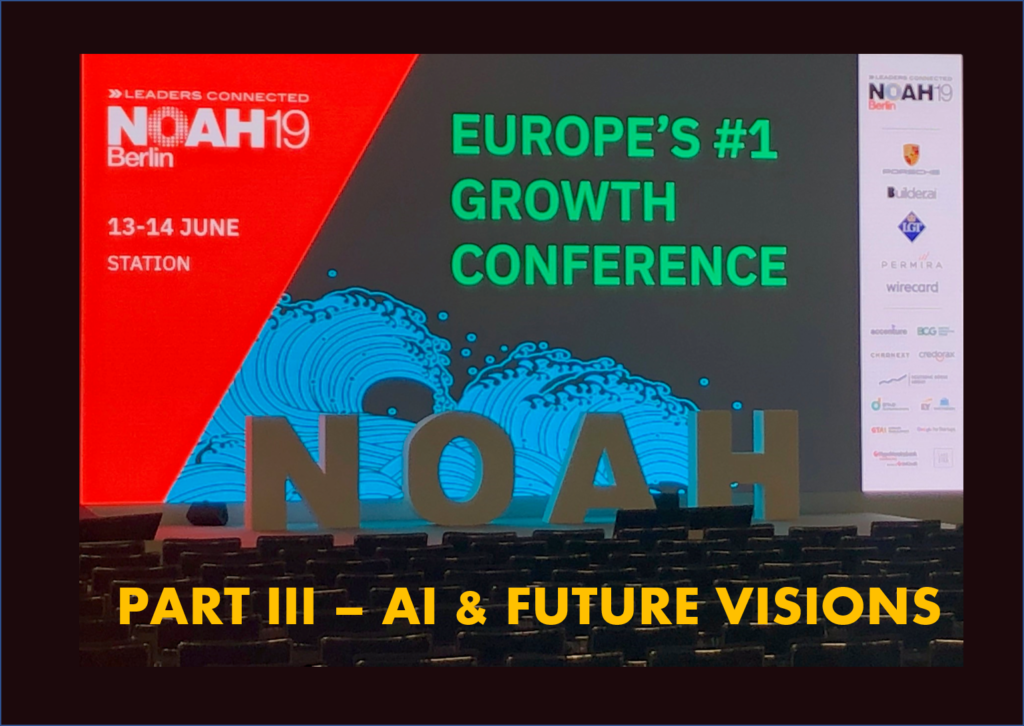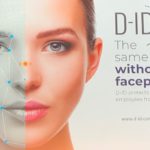At expert conferences, it is most valuable to hear well-founded views of where it is all heading. Especially from people who know (better than you do). Therefore, in our three-part summary of the NOAH 2019 conference in Berlin, there have to be a separate blog on the topic of ARTIFICIAL INTELLIGENCE (AI) and FUTURE STARS in digital services across Europe.

In the field of digital technologies and data there are some conferences in Europe worth seeing. On top of that, there are a few that you can feel really be sorry if missing them. Well, and at the top of this imaginary pyramid of know-how, there is a very short list of those conferences from which you will have goosebumps still several weeks after their closing. One such conference is the NOAH conference in Berlin, which I had the honor of attending few weeks ago. In a short three-part series I offer you a compacted summary of the most important of the 2019 edition.
 On the first day of the conference, I saw my jaw dropped at D-ID presentations. As their name suggests, they deal with the depersonalizing of personal data (which would not be a novelty itself), but now listen what. They focus on providing such a subtle alteration of your photos that all humans will still know it’s you, but none of the top image recognition tools on the market will be able to match your face with you. For example, if you add a photo to Facebook, the app won’t be able to tag you automatically. Even more fascinating, you can choose whether you want a “version of you” that preserves your physio-gnomic features (that is, you will not become a no-name and the photo will preserve your gender, race, approximate age) or you decide to suppress even those. Even in the highest “secrecy mode”, these are only pixel-level changes, any person can still recognize you from that photo, but no (publicly) available algorithm can. Truly fascinating.
On the first day of the conference, I saw my jaw dropped at D-ID presentations. As their name suggests, they deal with the depersonalizing of personal data (which would not be a novelty itself), but now listen what. They focus on providing such a subtle alteration of your photos that all humans will still know it’s you, but none of the top image recognition tools on the market will be able to match your face with you. For example, if you add a photo to Facebook, the app won’t be able to tag you automatically. Even more fascinating, you can choose whether you want a “version of you” that preserves your physio-gnomic features (that is, you will not become a no-name and the photo will preserve your gender, race, approximate age) or you decide to suppress even those. Even in the highest “secrecy mode”, these are only pixel-level changes, any person can still recognize you from that photo, but no (publicly) available algorithm can. Truly fascinating.
The presentation of the French company PROPHESEE (although from a different angle) also dealt with the field of optical recognition using AI. The long-term video analysis research has found that only less than 0.9% of the video image is needed to detect what is happening in the image. If you watch an CCTV camera, most of the image remains static (buildings, solid objects, …) and important for judging what is happening are moments when something moves in the image. This makes 99% of the transferred (pixel) data useless, especially if need to upload the image somewhere for processing. This may not seem important when having the luxury of large megabit optics to transfer it. But if you have an IoT device and images need to be sent through a low bandwidth, it becomes an insurmountable obstacle immediately. This problem has its origins in the fact that all currently available cameras are designed for human eye scanning, not for machine processing of the signal. The principle of frames (and their incremental comparison) is very computationally demanding. Prophesee has designed a camera (and supporting software) that reduces the need for video transmission by several orders of magnitude. What is more, it enables also fast and more accurate recognition what is happening on screen. They already have 51 patents on the subject and, being aware of the nature of convolutional networks, I believe that the method can soon be emulated to a certain extent solely by software. So we may expect a revolution in image recognition again.
If there are technologies from which you are both fascinated and embarrassed, then applications from CHORUS.AI is definitely one of those. This US-Israeli start-up has created a truly remarkable Natural Language Processing system that transcribes phone calls into text. So far, it would be nothing worldly. However, the real strength of CHORUS is that it analyzes also the call transcripts in relation to what the call was supposed to achieve. Thus, it can extract from the calls of a particular sales representative the way of selling, success of individual arguments, client objections and their handling. This slowly brings us to the slightly scary part of the system. For each salesman system can identify which words and sentences work for him, whether he gives reasonable discounts and how he works with information extracted from client. Consequently, it calculates the usefulness of the individual sales representatives. For the defense of the system it is necessary to say that it picks from the database past real calls those passages that correctly address agent’s weaknesses. It also automatically selects training calls to listen for a newcomer to rapidly teach him/her the skills needed. However, not fool ourselves, the fact that CHORUS.ai can increase call center efficiency by up to 30% makes it clear that some workers “are sent home”, too. And all of this happening in fully automated mode, with relentless data finger pointing on individual people. As I wrote above, expertly fascinating, socially a little, um, embarrassing.
While many fumble on how to turn AI into business benefits, AirHelp is quite clear about it. At the same time, this company is one of the use-cases of artificial intelligence that makes a clear sense, though you wouldn’t be looking for it in first place. The essence of their business is to help people recover from airlines reimbursement for missed and canceled flights. According to their estimates, claims for compensation of aircraft passengers amount to EUR 15 billion a year, but in fact only around EUR 2.3 billion, so around 15%, are paid. The business story of Airhelp is magical in a way that they used solely human Claim Handlers to represent their clients in the beginning. However, the influx of new cases for solicitation (filed via easy web form) has steadily increased, until the company suddenly found itself with an “army” of 500 people working as claim handlers. This was the moment when the owners realized it was not scalable and developed 3 AI systems to a] initially assess the merits of the case (and prioritize), b] estimate the probability of success of the case, and c] determine the most appropriate jurisdiction to claim the case. A single case handling lasting for human expert about 20 minutes can now be processed via AI solution in 23 milliseconds! Of course, they had to also arm themselves with a large number of API’s to various auxiliary systems. But thanks to this automation, they have become the largest law firm in the world, based on the number of cases represented in court. It is also remarkable that they have found new use in the company for those 500 people replace by computers , but on that note probably more details in some other blog posts later.
 From time to time, you will come across news that will surprise you, perhaps make you even wonder what it really means. For me, this was QWANT presentation. If someone tells you that they are creating an Internet search engine to be an alternative to Google, you get at least puzzled if not directly burst into laughter. However, these people are serious about it and I have to admit that their chances neither hopeless not necessarily high. If you browse to QWANT web-page and search for some key-words, you get results that are, indeed, truly comparable to Google. However, Qwant’s competitive advantage is that it does not collect any meta data about the users themselves and does not hue (or censor) the search results according to who is running the search. If you don’t believe in how important this really is, try a little experiment: pick up a friend and make a request to Google for the same key-words from your own computers and his/her computer at the same time. Go through the first few pages of Google search results on each of the computers and you will be surprised to contrast how different the results on both computers were. According to the presentation of the team, the Qwant search engine will probably have a much more friendly conditions for systematic crawling of information (using searches as crawler inputs). At the same time, it will be the European alternative, i.e. it will be guided by a stricter view of the digital privacy of people on the Internet, compared to its American counterpart(s).
From time to time, you will come across news that will surprise you, perhaps make you even wonder what it really means. For me, this was QWANT presentation. If someone tells you that they are creating an Internet search engine to be an alternative to Google, you get at least puzzled if not directly burst into laughter. However, these people are serious about it and I have to admit that their chances neither hopeless not necessarily high. If you browse to QWANT web-page and search for some key-words, you get results that are, indeed, truly comparable to Google. However, Qwant’s competitive advantage is that it does not collect any meta data about the users themselves and does not hue (or censor) the search results according to who is running the search. If you don’t believe in how important this really is, try a little experiment: pick up a friend and make a request to Google for the same key-words from your own computers and his/her computer at the same time. Go through the first few pages of Google search results on each of the computers and you will be surprised to contrast how different the results on both computers were. According to the presentation of the team, the Qwant search engine will probably have a much more friendly conditions for systematic crawling of information (using searches as crawler inputs). At the same time, it will be the European alternative, i.e. it will be guided by a stricter view of the digital privacy of people on the Internet, compared to its American counterpart(s).
The heart of the data analyst mush have cheered up at the presentation of FRESH ENERGY, which (quite in the spirit of its name) brings a new wind to the otherwise relatively dull industry of utilities and energy. In addition to being an alternative energy provider (mainly for electricity), they bring innovation in form of very interesting use of smart meetering sensors installed by them into homes. (they already have more than 1.7 billion sensors) They summed up their mission in the slogan “From MegaWatt to MegaValue” while they really do not perceive digital consumption meters merely as a practical substitute for human meter readings. From the time series of consumption pattern in individual household circuits, besides the obligatory proper billing, they are able to optimize electricity consumption (e.g. floating electricity price during the day). By being able to report the consumption down to level of specific household appliances, they can point to anomalies in consumption (which are often a precursor to appliance failure). They also came up with very unique solution to monitor seniors, for whom through their regular consumption patterns can be identified that are breaking some of the crucial habits (e.g. it’s 11 am already and senior has not yet brewed his regular coffee or has not put on the radio that belongs to his morning rituals. While raising these alerts senior’s relatives can call the him/her to see if (s)he was really okay. You may be surprised, but trust me the combination and intensity of use of specific electrical appliances will tell a lot about the household lifestyle as such. Therefore, the data derived from these smart meters can soon turn also into fairly high commercial asset.
If I asked you in what area of life the data analytics had hardly ever taken strong stand, many of you might have guessed the traditional areas of human manual work (e.g. construction) where digitization has not yet (fully) arrived. After all, the shovel and pickax have only a wooden handle and you won’t create too much data by using them. However, the CORRUX ‘s contribution refuted this stereotype by documenting that machine learning and deep-learning models already exist also in the construction industry. As the construction of new buildings and infrastructure accounts for almost 2% of world GDP, any savings or efficiency gains in this industry have widespread financial implications. The CORRUX company integrates into APIs already built into construction mechanisms and tools, reads the data from these devices & machines and then subjects the data to AI processing. In addition to (relatively) primitive indicators like the machine’s up-time efficiency, CORRUX also offers more sophisticated models for predictive maintenance or for quantifying the added value of various machines on the total cost of construction.
 The figurative icing on the cake were the presentations of VILLAGE POWER and PTScientists. The former deals with the problem of electricity shortages outside the main capital cities of the African continent. We may not even realize it, but the sheer availability of electricity supply allows us to significantly prolong the effective part of the day. For example, if you want to broaden your expert horizons through reading professional book after work, you can easily turn on the bedside lamp and read into that book until you snooze. However, in most rural areas of Africa, you do not read anything after dark, as there is pitch-dark and you have no light to read. More than 124 million households live without a permanent electricity supply. Lighting with candles or Diesel power generators is not only financially burdensome, but also dangerous for the environment. VILLAGE POWER therefore came up with the concept of installing portable photo-voltaic units via efficient network of local mobile operator branches. The pay-back time on such an investment for a family is approximately 15 months. I was also interested in the approach of this company because it contributes to the gradual electrification of households by the gamification of the use of individual household appliances (e.g. light first, then a washing machine, etc.). recalls Maslow’s pyramid of needs (in electricity).
The figurative icing on the cake were the presentations of VILLAGE POWER and PTScientists. The former deals with the problem of electricity shortages outside the main capital cities of the African continent. We may not even realize it, but the sheer availability of electricity supply allows us to significantly prolong the effective part of the day. For example, if you want to broaden your expert horizons through reading professional book after work, you can easily turn on the bedside lamp and read into that book until you snooze. However, in most rural areas of Africa, you do not read anything after dark, as there is pitch-dark and you have no light to read. More than 124 million households live without a permanent electricity supply. Lighting with candles or Diesel power generators is not only financially burdensome, but also dangerous for the environment. VILLAGE POWER therefore came up with the concept of installing portable photo-voltaic units via efficient network of local mobile operator branches. The pay-back time on such an investment for a family is approximately 15 months. I was also interested in the approach of this company because it contributes to the gradual electrification of households by the gamification of the use of individual household appliances (e.g. light first, then a washing machine, etc.). recalls Maslow’s pyramid of needs (in electricity).
Although Elona Muska‘s recent “haggies” in the field of space colonization somewhat tore this impression, I assume that if I asked who would be behind the first data network covering the Moon, you would probably guess some of the developed nations or their space organizations (like NASA or ESRO). Perhaps that’s why it will (like did to me) take your breath away that the “colonization” of the Moon will be taken mainly by private companies such as PTSCIENTISTS. Not only do they have scheduled several flights to Moon in the coming years, they are also able to sell about 300kg of cargo carrying capacity each flight they offer. The first mobile phone network on Moon is in the process of real preparation. This allows in further due easier installation of other technologies, and also would allow the robots brought there to survive on the moon for a long sustained time (which in turn will be forerunners for the arrival of the first humans for permanent missions there.) Even if you are not universe enthusiast, trust me, the opportunity to talk personally to the actual people who are planning these projects is a goosebumps experience. It gives you near touch with the future and it is fascinating that the NOAH conference can bring this to its participants. Therefore, if you have even a little chance, do not hesitate to look at it next year. I am sure you will leave full of impressions as I do this year. So maybe see you at NOAH 2020!
You have just read the second part of the inspiration from NOAH 2019 conference. You can read more fascinating information from this conference in the first or second part of this mini series.
Publikované dňa 25. 7. 2019.